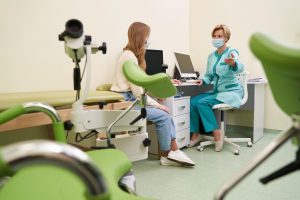The Connection Between Pelvic Pain and Interstitial Cystitis


Pelvic pain can be a distressing and often debilitating condition that affects millions of people, particularly women, around the world. While there can be various underlying causes for pelvic pain, one condition that frequently goes undiagnosed is Interstitial Cystitis (IC). IC, also known as painful bladder syndrome, is a chronic and painful condition that primarily affects the bladder, but its symptoms can extend beyond that organ. In this article, we will explore the intricate connection between pelvic pain and Interstitial Cystitis, shedding light on how they are intertwined and what you can do if you suspect you might be suffering from these conditions.
Understanding Interstitial Cystitis
Interstitial Cystitis is a chronic bladder condition characterized by recurring discomfort or pain in the pelvic area, along with frequent urination and a persistent urge to urinate. It’s essential to recognize that IC isn’t a urinary tract infection (UTI) or a bacterial infection. Instead, it’s believed to be an autoimmune or inflammatory condition that can affect the bladder’s lining. The symptoms of IC can vary in intensity, ranging from mild discomfort to severe, debilitating pain. Patients often describe the pain as a burning or stabbing sensation in the bladder and pelvic region. The symptoms of IC tend to come and go, causing periods of remission followed by flare-ups, which various factors like stress, diet, hormonal changes, or physical activity can trigger.
The Link Between Pelvic Pain and IC
One of the primary reasons that Interstitial Cystitis is often misdiagnosed or overlooked is its overlapping symptoms with other pelvic pain conditions. Conditions such as endometriosis, pelvic inflammatory disease, and irritable bowel syndrome (IBS) can exhibit similar symptoms, making it challenging to pinpoint the root cause of the pain. Women, in particular, may find it difficult to distinguish between pelvic pain associated with IC and other gynecological conditions.
Musculoskeletal Dysfunction:
Pelvic pain can also arise from musculoskeletal dysfunction, which can be closely linked to IC. Chronic pain in the pelvic area can lead to muscle tension and dysfunction in the pelvic floor muscles. These muscles are crucial in supporting the pelvic organs, including the bladder. When these muscles become tight or weakened due to chronic pain or inflammation associated with IC, it can exacerbate the discomfort and pelvic pain experienced by individuals.
Psychological Impact:
The chronic nature of Interstitial Cystitis and the associated pelvic pain can take a toll on an individual’s mental health. The constant pain and disruption to daily life can lead to anxiety, depression, and stress, all of which can further intensify the perception of pelvic pain. The psychological impact of living with a chronic condition like IC can create a vicious cycle, as stress and anxiety can trigger flare-ups, leading to more pain and distress.
Diagnosis and Treatment
Diagnosing Interstitial Cystitis can be challenging due to its overlapping symptoms with other conditions. However, if you’re experiencing chronic pelvic pain, frequent urination, or an urgent need to urinate, it’s essential to seek medical attention. A urologist or a specialist in pelvic pain can perform various tests and examinations to determine the cause of your symptoms.
Medical History and Physical Examination:
Your healthcare provider will start by taking a detailed medical history and conducting a physical examination. They will inquire about your symptoms when they started, and potential triggers or aggravating factors. During the physical examination, they may check for tenderness or discomfort in the pelvic region.
Urine Analysis:
A healthcare provider may perform a urine analysis to exclude urinary tract infections or other potential causes of your symptoms. IC does not associate with bacteria in the urine, so negative results for infection possibly indicate IC.
Cystoscopy:
A cystoscopy is a procedure that involves using a thin tube with a camera to examine the inside of the bladder. This is the gold standard for diagnosing IC, as it allows the healthcare provider to visualize any signs of inflammation or damage to the bladder lining.
Potassium Sensitivity Test:
In some cases, a potassium sensitivity test may be performed during cystoscopy. This test involves instilling a potassium chloride solution into the bladder to see if it triggers pain or discomfort, which indicates IC.
Treatment Options:
Once diagnosed with Interstitial Cystitis, treatment options can vary depending on the severity of symptoms. There is no one-size-fits-all approach, and treatment plans are often tailored to the individual’s needs. Some standard treatment options include:
Dietary modifications: Certain foods and beverages can trigger IC symptoms, so avoiding these triggers can help manage the condition.
Medications: Your healthcare provider may prescribe medications to reduce inflammation, alleviate pain, or calm overactive bladder muscles.
Physical therapy: Pelvic floor physical therapy can be beneficial in relieving pelvic pain and addressing musculoskeletal dysfunction.
Bladder instillations: Some individuals benefit from having medications or solutions instilled directly into the bladder through a catheter.
Neuromodulation: Nerve stimulation therapies can help manage IC symptoms for some patients.
Pelvic pain is a complex and multifaceted issue, and Interstitial Cystitis is just one of the many potential causes. Recognizing the connection between pelvic pain and IC is crucial for early diagnosis and appropriate treatment. If you or a loved one is experiencing chronic pelvic pain or related symptoms, it’s essential to consult with a healthcare provider who specializes in pelvic pain or urology. With the correct diagnosis and treatment plan, individuals living with Interstitial Cystitis can find relief and improve their quality of life. Remember, you don’t have to endure pelvic pain in silence; seek help and take steps toward a pain-free future.
